Imperial County, California
Sphingidae Adults
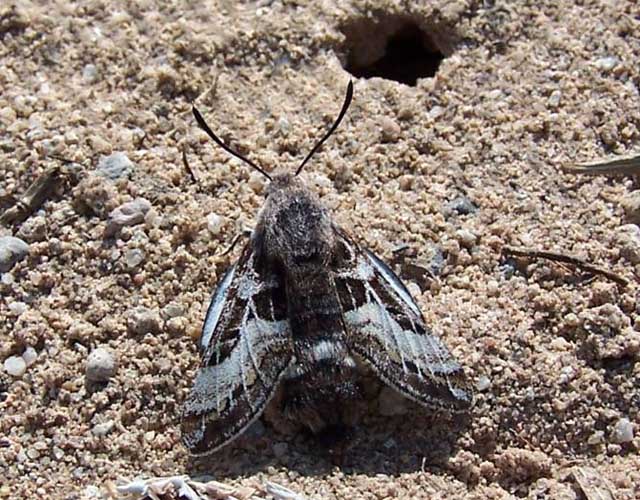
Euproserpinus phaeton "mojave" female, nearby Yuma, Arizona,
January 2, 2009, courtesy of Jennifer L. Bundy.
This page is dedicated to and inspired by Jennifer L. Bundy for her abiding interest in lepidoptera.
Jenifer L. Bundy writes, "I have fully reared E. phaeton from ova to 5th this year from stock collected in another locality not well studied -
lower Imperial Co., CA. The larvae shots I have from 1st instar to around 3rd are nearly identical, morphological wise, to E. euterpe."
Thirty-two Sphingidae species are listed in the USGS for
California. Not all of the species are reported by USGS
or anticipated in Imperial County (eight species recorded).
It is hoped that
this checklist, with the thumbnails and notes, will help you
quickly identify the moths you have encountered.
A WO" after the species name indicates that
I have no confirmed reports of these species in San Diego County, but
I (William Oehlke) expect that these moths (Sphinx chersis,
Eumorpha fasciata (as a stray) and Proserpinus clarkiae
may be present.
A USGS indicates the
moth is reported on the USGS website and/or in Moths of Western
North America, #2. Distribution of Sphingidae of Western North America, revised,
an excellent little booklet available through Paul Opler.
Please help me develop this list with improved, documented accuracy by
sending sightings (species, date, location), preferably with an
image, via email to
Bill Oehlke.
Sphinginae subfamily
Sphingini tribe:
 |
This species might be enountered in Imperial County and in other
southern California counties as a stray.
The moth is a very strong flier and
is frequently encountered far north of its usual range.
|
 |
This large bodied moth flies in tobacco fields and vegetable gardens
(potatoes, tomatoes) and wherever host plants are found. |
 |
This species is recorded in San Diego County. It does not range much further north, however.
Look for three large yellow spots
on each side of the abdomen.
|
 |
This species is recorded in San Diego County.
If you grow tomatoes, you have probably encountered it.
Larvae get very large and can strip a tomato plant. |
 |
Sphinx chersis
WO, the Northern Ash
Sphinx or Great Ash Sphinx
The upperside of the forewing is soft dark gray to blue-gray
with a series of black dashes,
one of which reaches the wing tip. |
Smerinthini Tribe:
 |
This one is quite similar to Pachysphinx modesta, with modesta
being smaller and darker.
Moths should be on the wing from June-August.
|
 |
Smerinthus cerisyi USGS, the Cerisyi's
Sphinx or One-eyed Sphinx, Larvae feed on poplars and willows.
Flight would be from late May-July as a single brood.
|
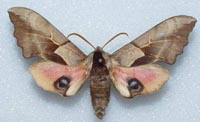 |
Smerinthus saliceti
USGS, the Salicet
Sphinx, flies in valleys and along streamsides from Mexico City north
to west Texas, southern Arizona, and extreme southern California.
Larvae feed on poplars and willows.
Flight would be from late April-September, probably as a double brood.
|
Macroglossinae subfamily
Dilophonotini Tribe:
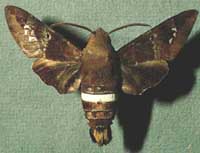 |
The body is dark brown with a wide white
band across the abdomen. Wings are dark brown. The forewing has a
black cell spot and 3 white spots near the pale brown marginal
area. unlikely stray |
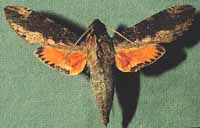 |
This species is more likely to occur as an occasional stray rather than as a breeding resident.
As a migrant stray it would be seen later in the season, July-August. |
 |
The abdomen has very distinct gray and black bands.
Adults nectar at dusk so you may see them in the garen at that time. |
 |
During the night adults nectar at flowers, including bouncing bet
(Saponaria officinalis) and Asystasia gangetica beginning at dusk.
July and August are flight times in the southern states.
|
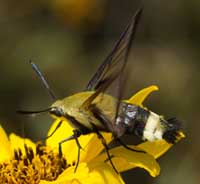 |
Hemaris thetis WO, the Thetis Clearwing or Bee Hawk Moth,
The moth flies along forest edges and in meadows, gardens and
brushy fields. Day-flying adults nectar at lantana, dwarf bush honeysuckle,
snowberry, orange hawkweed, thistles, lilac, Canada violet, etc.
|
Philampelini Tribe:
 |
This moth is reported for San Diego County, and might be present in Imperial County.
Fight would be from June to August. Larvae feed on grape foliage. |
 |
This moth is a very strong flier and is often reported far north of
its normal range. It would be a rare stray to Imperial County if it is
at all present. Moths tend to follow rivers and streams.
|
Macroglossini Tribe:
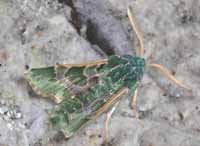 |
Arctonotus lucidus WO, the Pacific Green
Sphinx Moth or Bear SphinxThis species is confirmed in Riverside
County. It might be present in Imperial County.
It tends to be an late winter-early spring flier, on the
wing in the early evening. It comes to lights at night. |
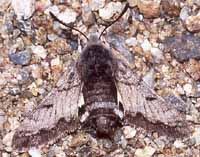 |
Adults nectar at flowers during the warm parts of the day.
Euproserpinus phaeton adults fly swiftly and close to the ground over
dry washes and flat areas in deserts as a single brood from
February-April.
|
 |
Hyles lineata
USGS, the White-lined Sphinx
Adults usually fly at dusk, during the night, at dawn, and during the
day. Moths nectar at salvia and other flowers and oviposit on
Epilobium cana (California fuchsia) and Hooker's Evening
Primrose, and others. |
|
|
Enjoy some of nature's wonderments, giant silk moth cocoons.
These cocoons are for sale winter and fall. Beautiful Saturniidae moths will emerge the following spring and summer.
Read Actias luna rearing article. Additional online help available.
Use your browser "Back" button to return to the previous page.
This page is brought to you by
Bill Oehlke and the
WLSS. Pages are on space rented from Bizland. If you would like
to become a "Patron of the Sphingidae Site", contact Bill.
Please send sightings/images to Bill. I will do my best to respond to
requests for identification help.
 | 
Show appreciation for this site by clicking on flashing butterfly to the left.
The link will take you to a page with links to many insect sites. |

